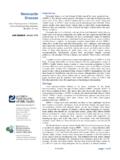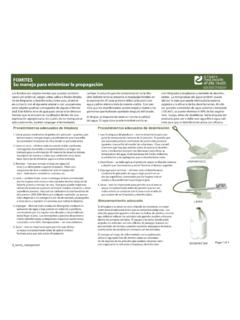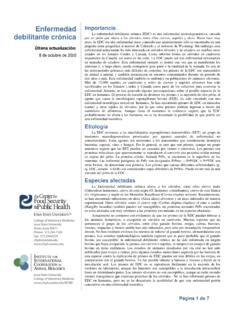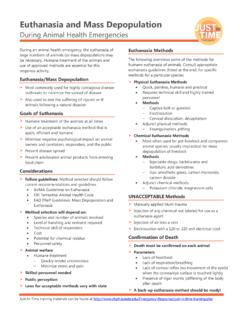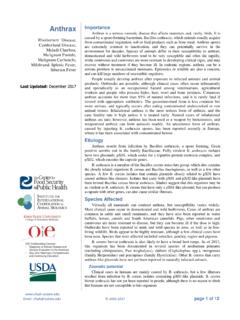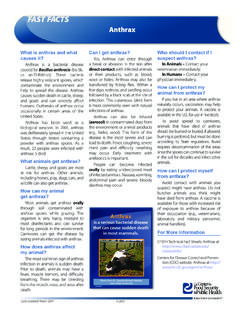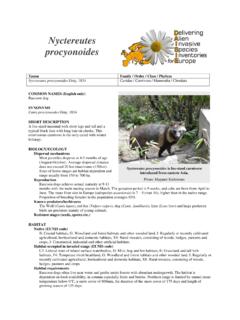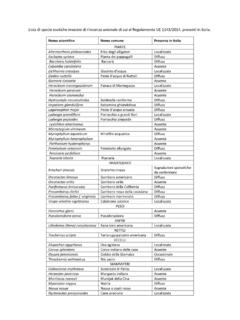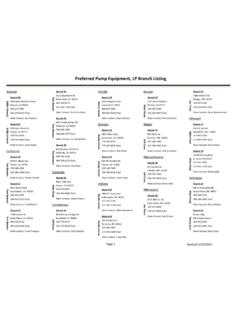Transcription of Vesicular Importance Stomatitis - Iowa State University
1 Email: 2005-2020 page 1 of 8 Vesicular Stomatitis Sore Mouth of Cattle and Horses, Indiana Fever Last Updated: January 2016 Importance Vesicular Stomatitis is an important viral disease of livestock in the Americas. It can affect ruminants, horses and pigs, causing vesicles, erosions and ulcers on the mouth, feet and udder. Although deaths are rare, these lesions can result in pain, anorexia and secondary bacterial mastitis, and some animals may lose their hooves after developing laminitis. Vesicular Stomatitis viruses are endemic from southern Mexico to northern South America, but regularly spread north and south from these regions, causing outbreaks and epidemics.
2 While these viruses are no longer endemic in the , they are introduced periodically into the southwestern states, and can sometimes spread farther north. These outbreaks end after freezing temperatures kill the insect vectors that transmit Vesicular Stomatitis ; however, the introduced viruses may overwinter for a year or two, re-emerging in the spring. Vesicular Stomatitis is clinically indistinguishable from several other Vesicular diseases of livestock including foot-and-mouth disease (FMD). Prompt diagnosis is important not only for containing Vesicular Stomatitis outbreaks, which can restrict international trade, but also in preventing major livestock diseases such as FMD from spreading undetected.
3 People who work with Vesicular Stomatitis viruses or come in close contact with infected animals sometimes become infected and develop an influenza-like illness. Etiology Vesicular Stomatitis can be caused by four named viruses in the genus Vesiculovirus (family Rhabdoviridae): Vesicular Stomatitis New Jersey virus (VSV-NJ), Vesicular Stomatitis Indiana virus (VSV-IN), Vesicular Stomatitis Alagoas virus (VSV-AV) and Cocal virus. The viruses that cause Vesicular Stomatitis have been divided into two major serotypes, New Jersey and Indiana.
4 VSV-NJ belongs to the New Jersey serotype. The remaining three viruses are members of the Indiana serotype, which is currently subtyped serologically into 3 groups. VSV-IN belongs to the Indiana 1 subtype, Cocal virus to the Indiana 2 subtype, and VSV-AV to Indiana 3. The genus Vesiculovirus also contains several related viral species, which, as of 2014, included Piry virus, Maraba virus, Isfahan virus and Chandipura virus. Chandipura virus has been associated with influenza-like illnesses and encephalitis in humans in India. This virus may also infect ruminants and pigs in the area, based on serological studies, although there is currently no evidence that it causes disease in these species.
5 Isfahan virus may circulate between gerbils, sandflies and people in the Middle East, but it is not thought to infect domesticated animals. Piry and Maraba viruses were found in South America. Experimental infection with Piry virus caused Vesicular lesions at the inoculation site in horses but not in any ruminant species. Maraba virus has only been isolated from insects. None of these viruses, including Chandipura virus, is currently considered to be an agent of the livestock disease Vesicular Stomatitis . However, they are thought to be pathogens or potential pathogens for people working in laboratories.
6 Additional vesiculoviruses have been reported in the literature, but have not yet been officially accepted as separate viral species. Species Affected Vesicular Stomatitis mainly affects equids, cattle and swine. Sheep and goats can develop clinical signs, although this is uncommon, and South American camelids have also been affected. Antibodies to Vesicular Stomatitis viruses (VSV) have been found in many other species including deer, pronghorn (Antilocapra americana), bighorn sheep (Ovis canadensis), bats, raccoons (Procyon lotor), opossums (Didelphis marsupialis), anteaters (Tamandua tetradactyla), bobcats (Lynx rufus), bears, wild canids, dogs, non-human primates, rabbits, various rodents, fruit bats (Artibeus spp.)
7 , turkeys and ducks. Additional non-livestock species ( , guinea pigs, hamsters, mice, ferrets, opossums, chickens) have been infected experimentally. Livestock are not thought to maintain Vesicular Stomatitis viruses long term, and their reservoir or amplifying hosts are unknown. Deer mice (Peromyscus sp.) can become viremic, and small rodents have been proposed as possible reservoir hosts; however, Vesicular Stomatitis 2005-2020 Email: page 2 of 8 this remains speculative. Some authors have even suggested that Vesicular Stomatitis viruses might be plant viruses found in pastures, with animals at the end of an epidemiological chain.
8 Zoonotic potential Humans can be infected with Vesicular Stomatitis viruses, and may become ill. Geographic Distribution Vesicular Stomatitis viruses are endemic in southern Mexico, Central America, and northern South America. VSV-NJ was also endemic on Ossabaw Island, Georgia in the for decades; however, recent surveys could find no evidence for its presence. Reductions in the feral swine population on this island may have resulted in its eradication. VSV-NJ and VSV-IN regularly cause outbreaks in areas of North and South America where they are not endemic.
9 However, viruses are not maintained in these regions long term. VSV-AV and Cocal virus have been only been detected in limited areas of South America, to date. Vesicular Stomatitis is not thought to be endemic outside the Western Hemisphere, although other vesiculoviruses do circulate in the Eastern Hemisphere. Transmission The transmission of Vesicular Stomatitis is incompletely understood. The relative Importance of the various transmission routes in each situation is also sometimes unclear. Insect vectors are thought to introduce VSV into populations of domesticated animals.
10 Sand flies (Lutzomyia sp.), blackflies (family Simuliidae) and Culicoides midges can act as biological vectors. Sand flies seem to be important vectors in endemic areas, but have a limited flight range and are not thought to spread these viruses long distances. Blackflies are believed to be particularly important vectors in parts of the western Where the virus originates, before entering livestock populations, is still uncertain. Once animals develop lesions, however, insects may become infected by feeding on viruses in these lesions or contaminated secretions.



